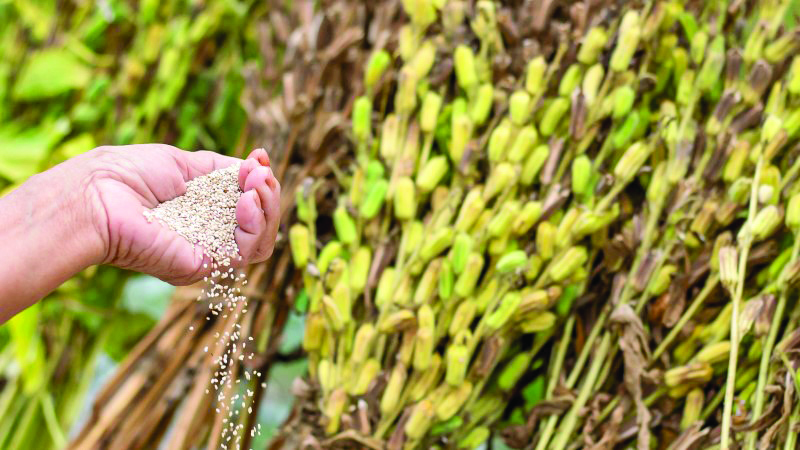Rajasthan, with its arid landscapes and chilly winter months, has cultivated a culinary heritage deeply rooted in hearty, nutritious, and locally grown grains. As the winter breeze sweeps through the Thar Desert, millets take center stage on the plates of Rajasthani households, offering not only a delicious array of dishes but also a myriad of health benefits.
Millets: The Winter Warriors
Bajra – The Pearl of Rajasthan’s Fields:
Bajra, or pearl millet, stands as the quintessential winter grain in Rajasthan. Its resilience to arid conditions makes it a staple crop, and during the winter, it becomes the foundation of many traditional dishes. Bajra roti, a flatbread made from bajra flour, is a warming delight enjoyed with various accompaniments.

Jowar – The Nutrient-Rich Sorghum:
Jowar, or sorghum, is another grain that graces the winter tables of Rajasthan. Its high fiber content and essential nutrients make it an excellent choice for maintaining energy levels during the colder months. Jowar-based dishes, such as bhakri and porridge, offer a wholesome and nutritious dining experience.

Culinary Delights:
Bajra Roti – A Winter Staple:
Bajra roti, unleavened flatbread made from bajra flour, is a symbol of winter dining in Rajasthan. Its rustic texture and earthy flavor provide the perfect accompaniment to hearty winter curries. The slow-release energy from bajra keeps the body warm and sustained throughout the day.

Jowar Bhakri – Savoring Nutrient Density:
Jowar bhakri, a thicker and heartier flatbread, is a popular winter choice. Packed with nutrients, it pairs well with robust curries and stews, creating a wholesome meal that not only satisfies the taste buds but also nourishes the body.
Health Benefits:
Rich in Fiber and Nutrients:
Millets, including bajra and jowar, are rich in dietary fiber and essential nutrients. Their inclusion in winter meals aids digestion and provides a sustained release of energy, helping individuals stay active during the colder days.

Blood Sugar Regulation:
The complex carbohydrates in millets contribute to stable blood sugar levels, making them an ideal choice for individuals looking to manage their blood sugar during the winter season.
Seasonal Adaptability:
Diverse Millet Preparations:
Rajasthani cuisine showcases the versatility of millets through various preparations. From steamed bajra khichdi to jowar porridge, the adaptability of millets allows for a diverse and flavorful range of dishes, ensuring a fulfilling winter diet.
Millets in Sweets:
Millets find their way into Rajasthani sweets during the winter months. Bajra and jowar are used to create delicacies like laddoos and halwas, providing a sweet treat that is not only tasty but also nourishing.

Sustainable Farming Practices:
Millets and Water Conservation:
The cultivation of millets aligns with sustainable farming practices in the water-scarce regions of Rajasthan. These hardy crops require less water compared to other grains, contributing to water conservation efforts and promoting ecological balance.
Preserving Agricultural Heritage:
The cultivation and consumption of millets reflect the agricultural heritage of Rajasthan. Farmers, generation after generation, have embraced these resilient grains, preserving not only a traditional way of life but also contributing to the region’s food security.
The Cultural Tapestry:
Festivals and Millets:
Winter festivals in Rajasthan, such as Makar Sankranti, are incomplete without the presence of millet-based dishes. The celebratory feasts highlight the cultural significance of millets in the culinary traditions of the region.
Community Celebrations:
The preparation and sharing of millet-based dishes foster a sense of community and togetherness. From traditional kitchens to bustling markets, the aroma of millet-based delights permeates the air, creating a communal experience that transcends the dining table.
In conclusion, the prominence of millets in Rajasthan’s winter cuisine goes beyond mere sustenance. It is a celebration of resilience, sustainability, and cultural heritage. From bajra roti to jowar bhakri, these grains not only warm the body but also nourish the spirit, making them an integral part of the vibrant tapestry that is Rajasthani cuisine. As the winter sun sets over the desert, millets continue to shine as the grains of warmth and wellness on every Rajasthani plate.














